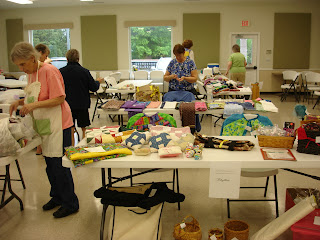First you have to prepare the 2 1/2" strips of fabric. I used a jelly roll of batiks.
This is tedious and time consuming, and you iron lots more than you ever willingly did before in your life, depending on the size bowl you are making. I used half of my jelly roll, which turned out to be 880" more or less, which is equivalent to over 73 feet, once the strips had been joined to each other. I don't think I've ever ironed 73 feet of anything, even cumulatively, in my lifetime, especially since "iron" is the original four letter word.
You fold the strip wrong sides together, much as you would if you were preparing binding, and iron. This creates a nice crease at the longitudinal halfway point of the strip. Then you fold each long side in to this midpoint and reiron, creating finished edges that look like the strip above. So now, as if 73 feet weren't bad enough, you RE-iron those same 73 feet on each side of the original fold! This now is over 219 feet of ironing, which makes some of us want to just forget it and run away from home. Only the promise that this part of the project was over permanently kept me from bailing at this point.
Next you place a soft cotton clothesline down the middle of this strip, right in the first fold you ironed. Then fold the left side over the clothesline and snug it up tightly. Next fold over the right side, encasing the clothesline snugly, and sew with a straight stitch down the middle of this tube you have created. I found that it was easier to use a long stitch while doing this. And I reset my Husqvarna Viking Designer I to heavy fabrics as well.
The next part isn't fun at first, but becomes exciting later on. You fold about 1/2" of your covered clothesline back on itself and sew with the widest zigzag stitch on the side edge, keeping the original stitch line on the outside of the fold. This is very awkward to do at first, and you wonder if your machine will really be able to handle that thickness and still produce a nice stitch, but it works out, don't worry. Sewing the strip this way keeps continually covering over the original stitch line as you add more and more loops around the original 1/2" starter loop. That leaves a nice, smooth edge on the outside (not the side you are seeing) of the resulting bowl. And, since you see this stitching inside and out, color coordinate both your bobbin and your upper thread to the fabric of the bowl.
The last part is to put the binding on the top of the bowl. I chose to pin the binding on the inside of the bowl, sew it in place, and then fold it out over the edge of the bowl and zig zag it down so that the sewing on the finished edge looked like the zigzag stitching in the rest of the bowl.
And here's the finished product! Now, that wasn't so hard, was it? I might even do another one of these in the near future. I can think of all kinds of gifts you could make with these: they could hold pots of flowers, pinecones and scented potpourri, trick or treat goodies, dinner rolls, fat quarters; smaller and more shallow ones for bureau top catch-alls or for toiletries in guest bathrooms; larger tall ones for hampers, medium height ones for toilet paper hiders in the bathroom or large shallow ones for holding magazines -- the possibilities are limited only by one's imagination!



























